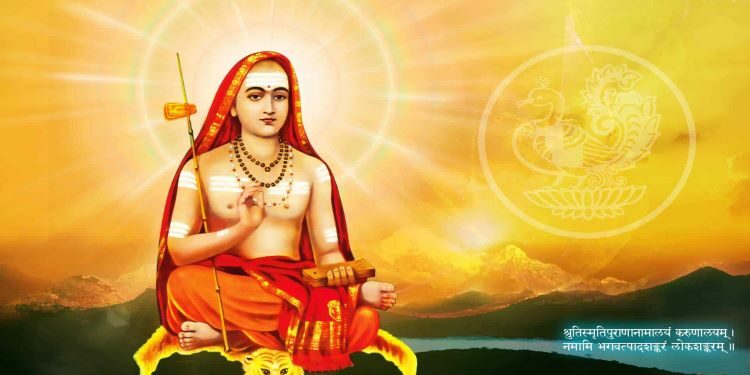In news : The Vice President of India while Delivering the first P. Parameswaran Memorial Lecture organised by Bharatheeya Vichara Kendram in Thiruvananthapuram mentioned about Jagadguru Adi Shankaracharya
About Jagadguru Adi Shankaracharya
- Adi Shankaracharya was an Indian philosopher and theologian who consolidated the doctrine of Advaita Vedanta
- Birth: The Sringeri records state that Shankara was born in the 14th year of the reign of “Vikramaditya”, but it is unclear as to which king this name refers to.
- Shankara was born in the southern Indian state of Kerala, according to the oldest biographies, in a village named Kaladi
- In the 8th century, Jagadguru Adi Shankaracharya integrated diverse thoughts and practices through his philosophy of Advaita Vedanta.
- Shankaracharya’s works in Sanskrit discuss the unity of the Ātman and Nirguna Brahman “brahman without attributes”
- His works elaborate on ideas found in the Upanishads. Shankara’s publications criticised the ritually-oriented Mīmāṃsā school of Hinduism.
- He wrote copious commentaries on the Vedic canon (Brahma Sutras, Principal Upanishads and Bhagavad Gita) in support of his thesis
- He also explained the key difference between Hinduism and Buddhism, stating that Hinduism asserts “Ātman (Soul, Self) exists”, while Buddhism asserts that there is “no Soul, no Self”
- He toured all the Indian Subcontinent to propagate his philosophy through discourses and debates with other thinkers.
- He established the importance of monastic life as sanctioned in the Upanishads and Brahma Sutra, in a time when the Mīmāṃsā school established strict ritualism and ridiculed monasticism.
- He is reputed to have founded four mathas (“monasteries”), which helped in the historical development, revival and spread of Advaita Vedanta of which he is known as the greatest revivalist
- Adi Shankara is believed to be the organiser of the Dashanami monastic order and unified the Shanmata tradition of worship.
- Adi Sankara is believed to have died aged 32, at Kedarnath in the northern Indian state of Uttarakhand, a Hindu pilgrimage site in the Himalayas.
His works
- His works are the foundation of Advaita Vedanta school of Hinduism, and his doctrine, states Sengaku Mayeda, “has been the source from which the main currents of modern Indian thought are derived”
- Shankaracharya is most known for his systematic reviews and commentaries (Bhasyas) on ancient Indian texts.
- His masterpiece of commentary is the Brahma Sutra Bhasya (literally, commentary on Brahma Sutra), a fundamental text of the Vedanta school of Hinduism
- His commentaries on ten Mukhya (principal) Upanishads are also considered authentic by scholars,and these are:
- Bhasya on the Brihadaranyaka Upanishad
- the Chandogya Upanishad
- the Aitareya Upanishad
- the Taittiriya Upanishad
- the Kena Upanishad
- the Isha Upanishad
- the Katha Upanishad
- the Mundaka Upanishad
- the Prashna Upanishad, and
- the Mandukya Upanishad.
- Of these, the commentary on Mandukya, is actually a commentary on Mandukya-Karika by Gaudapada
- Other authentic works of Shankara include commentaries on the Bhagavad Gita (part of his Prasthana Trayi Bhasya).
- His Vivarana (tertiary notes) on the commentary by Vedavyasa on Yogasutras as well as those on Apastamba Dharma-sũtras (Adhyatama-patala-bhasya) are accepted by scholars as authentic works of Shankara
Concept of Advaita non-duality()philosophy
Advaita Vedānta is a school of Hindu philosophy, and is a classic system of spiritual realization in Indian tradition. The term Advaita refers to the idea that Brahman alone is ultimately real, the phenomenal transient world is an illusory appearance (maya) of Brahman, and the true self, atman, is not different from Brahman.
Originally known as Puruṣavāda and as māyāvāda, the followers of this school are known as Advaita Vedantins, or just Advaitins regarding the phenomenal world as mere illusory appearance of plurality, experienced through the sense-impressions by ignorance (avidya), an illusion superimposed (adhyāsa) on the sole reality of Brahman
















